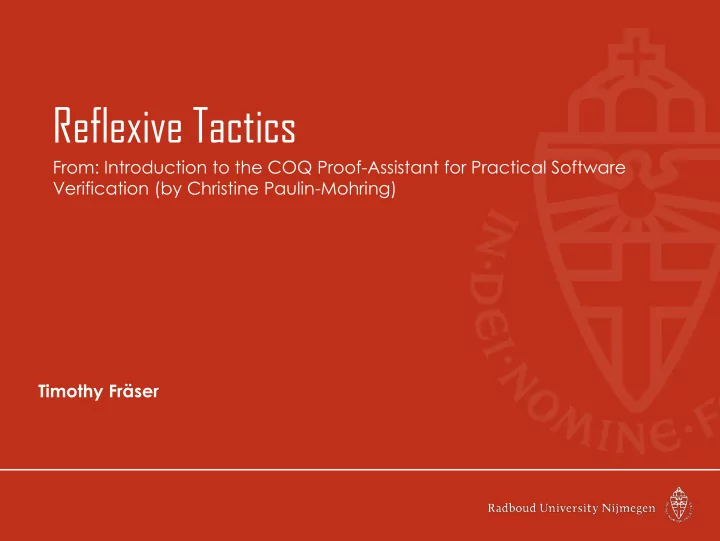

Reflexive Tactics From: Introduction to the COQ Proof-Assistant for Practical Software Verification (by Christine Paulin-Mohring) Timothy Fräser
Ltac • by David Delahaye • language for creating complex tactics without ML code COQ has a functional CAML kernel • combining tactics in Ltac can be inefficient and create large proof terms • another idea is to program a tactic inside COQ
Why use Reflexive Tactics? • to proof a property P:Prop • given a mechanical way of proving P based on it's structure • problem: cannot reason directly about the structure of P inside COQ
How to use Reflexive Tactics? • can reason about the structure of inductive types (data) • so we represent P as a term having an inductive type D - called reification - ex: an Abstract Syntax Tree
Algorithms • Every property P needs a data representation d:D • d2P : D → Prop - interpretation of the data-type (converts d:D to P ) • d2b : D → bool - given mechanical way of proving P based on it's structure - d2b needs to be correct - d2b needs to be efficient. • correct : ∀d:D, d2b d = true → d2P d
Convertibility Rule • important rule of COQ theory Γ ⊢ U:s Γ ⊢ t:T T ≡ U ───────────────────────── Γ ⊢ t:U • computation (for T ≡ U ) becomes part of type checking • termination: important to keep decidability of type checking • compatible with all languages having possible computations in their terms
Reflexifity “Rule” • convertibility rule: Γ ⊢ U:s Γ ⊢ t:T T ≡ U ───────────────────────── Γ ⊢ t:U • reflexifity "rule": refl_eq : true = true d2b d ≡ true ───────────────────────────────────── refl_eq : d2b d = true • provability completely depends on convertibility ( d2b d ≡ true )
Example 1: from data d to Property P (* data-type *) Inductive form : Set := | T | F | Var : nat -> form | Conj : form -> form -> form. (* environment for un-interpretable sub-propositions *) Definition env := list Prop. Fixpoint find_env (e:env) (n:nat) := match e with nil => True | cons x xs => match n with 0 => x | S p => find_env xs p end end.
Example 1: from data d to Property P (* data-type -> P *) Fixpoint d2P e (f:form) {struct f} : Prop := match f with T => True | F => False | Conj p q => d2P e p /\ d2P e q | Var n => find_env e n end. Notation "x :: xs" := (cons x xs). (* compute data-type -> P *) Definition e := (True :: False :: (0=0) :: nil). Eval compute in (d2P e (Conj (Var 0) (Conj (Var 2) (Var 1)))). (* outputs : "= True /\ 0 = 0 /\ False : Prop" *)
Example 2: Reification (* compute environment from formula *) Ltac env_form l f := match f with True => constr:(l,T) | False => constr:(l,F) | ?A /\ ?B => match env_form l A with (?l1,?A1) => match env_form l1 B with (?l2,?A2) => constr:(l2, Conj A1 A2) end end | ?A => let n := eval compute in (length l) in constr:(cons A 1, Var n) end.
Example 2: Reification (* P -> data-type (reify) *) Ltac reify := match goal with |- ?P => match (env_form (nil (A:=Prop)) P) with (?l,?f) => let e := eval compute in (rev l) in change (d2P e f) end end. (* compute P -> data-type (reify) *) Lemma test1 : 0=0 /\ False -> False /\ 1=1 /\ (0=0). reify. (* outputs : 1 subgoal ============================ d2P ((0 = 0)::(False -> False)::(1 = 1)::(0 = 0)::nil) (Conj (Var 0) (Conj (Var 1) (Conj (Var 2) (Var 3)))) *)
Recommend
More recommend